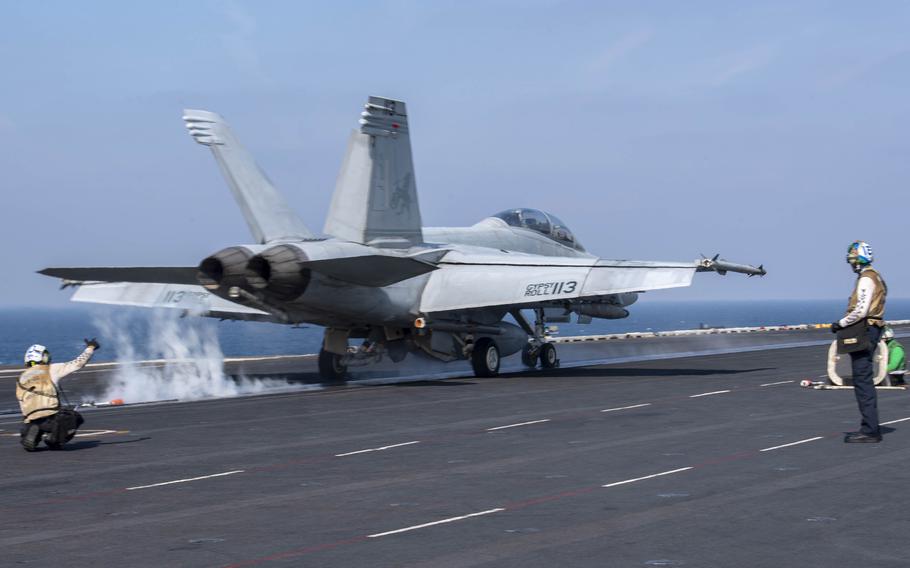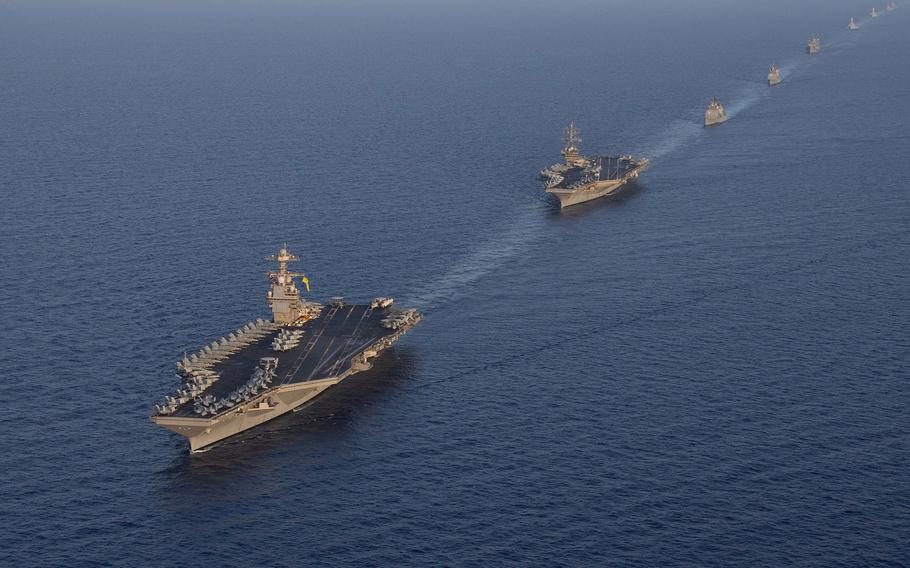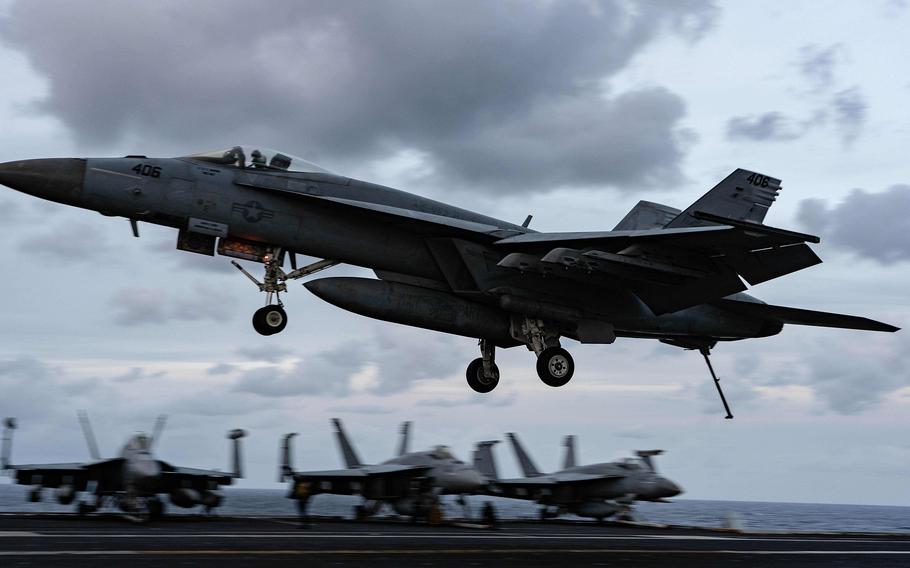
An F/A-18F Super Hornet fighter jet takes off from the aircraft carrier USS Dwight D. Eisenhower in the Persian Gulf on Dec. 1, 2023. The Eisenhower and its carrier strike group are deployed to the U.S. 5th Fleet area of operations. (Janae Chambers/U.S. Navy)
NAPLES, Italy — The Navy’s decision to keep two aircraft carriers near Israel will make it difficult to meet maintenance schedules unless one returns home by early next year, analysts say.
Defense Secretary Lloyd Austin has ordered USS Gerald R. Ford and the cruiser USS Normandy to remain in the region for several more weeks, The Associated Press reported Friday.
Ford deployed from Norfolk, Va., in May, but had its November homecoming delayed following the Oct. 7 Hamas attack on Israel. The USS Dwight D. Eisenhower arrived in the region in October for its scheduled deployment.
Beyond their immense combat and surveillance capabilities, the aircraft carriers serve as a potent political symbol of support for Israel, which has been criticized for civilian casualties and the displacement of most of Gaza’s population during its war to annihilate Hamas.
But while the aircraft carriers have kept busy, they haven’t pushed their limits.
Ford conducted 2,489 sorties, or flights, from Oct. 9 through Dec. 7, Cmdr. Richlyn Ivey, a spokesperson for U.S. Naval Forces Europe-Africa/U.S. 6th Fleet, said in an Dec. 12 email. Eisenhower tallied 2,051 sorties from Oct. 24 through Dec. 7, she said.
That’s a daily average of about 41 for Ford and 45 for Eisenhower. The carriers are designed to surge to as many as 270 and 240 sorties, respectively, over a 24-hour period, according to the Navy.

Aircraft carriers USS Gerald R. Ford and USS Dwight D. Eisenhower sail with other U.S. and allied ships sail in the Mediterranean Sea on Nov. 3, 2023. The carriers have flown more than 4,500 sorties since the start of Israel-Hamas war in October, the Navy said. ( Jacob Mattingly/U.S. Navy)
The service didn’t offer additional details about the carriers’ activities or operations. Besides flights, the carrier strike groups’ myriad capabilities include long-range missile tracking and intelligence gathering.
But the flight activity suggests Ford could return stateside for needed maintenance and crew rest without undercutting U.S. efforts to keep Iran-backed proxies from broadening the war into a regional conflict, analysts say.
“The strategic signaling has fulfilled its purpose,” said Johannes Peters, department manager of the Center for Maritime Strategy and Security at Kiel University in Germany.
Pro-Iran groups have launched dozens of drone and missile attacks on U.S. bases in Iraq and Syria since the war began, while the Iran-backed Houthis in Yemen have launched missiles at shipping in the Red Sea. However, Iran’s national forces haven’t publicly entered the fray.
Meanwhile, Hezbollah has skirmished with Israel from the Lebanon border. But Peters noted they aren’t heavily engaged in the fighting. At current levels of conflict, two carriers aren’t necessary, Peters said.
Ford’s continued deployment could have future impacts upon the larger fleet, according to naval analysts. Maintenance backlogs, crew fatigue and shortages, and shipyard decay were among contributing factors found to be hurting Navy readiness, according to a Government Accountability Office report released in May.
“If we try to do it all, everywhere, we will strain the fleet once again and weaken ourselves should a hot war erupt that directly involves the U.S. as a combatant,” said James Holmes, who chairs the maritime strategy program at the Naval War College in Newport, R.I.
The Navy still is working through a maintenance backlog left over from the last time the U.S. kept a constant one- or two-carrier presence in the Middle East at the height of the Iraq and Afghanistan wars, Holmes said
The Navy did not answer Stars and Stripes questions last week about the impact of an extended deployment on Ford’s maintenance schedule.
While the dual-carrier operations are a strain on the service, the flexibility to take action is important, said Sebastian Bruns, a naval security expert with the Center for Strategic and International Studies, a Washington-based think tank.
For example, there still is the possibility of a noncombatant evacuation operation from Lebanon.
And while a carrier deployment sends a political signal to a region, its departure sends one as well, Bruns said.

An F/A-18E Super Hornet lands on the aircraft carrier USS Gerald R. Ford on Dec. 6, 2023. The Ford Carrier Strike Group is currently operating in the Mediterranean Sea. (Maxwell Orlosky/U.S. Navy)
The service has 11 aircraft carriers, of which five are underway or deployed, according to a USNI News report Dec. 11. Two are in various stages of maintenance, according to posts on official social media pages for USS John C. Stennis and USS George H.W. Bush, while USS Harry S. Truman ended its maintenance period Sunday.
USS Abraham Lincoln and USS George Washington appear to be readying for future deployment. USS Nimitz is undergoing planned maintenance but is set for decommissioning in 2026, according to the Navy’s 2024 shipbuilding plan.
There are some signs the Navy is adjusting its force posture in the Mediterranean and Middle East. Three U.S.-based destroyers transited the Strait of Gibraltar eastbound within the last week.
There are 19 Navy ships in the region, including at least seven in the eastern Mediterranean and 12 in the Red Sea, Arabian Sea and Persian Gulf, AP reported Friday.
That destroyer presence could pick up where Ford would leave off, analysts say.
The Navy’s destroyer fleet has been active in bringing down missiles and drones heading Israel’s way. The USS Mason, USS Carney and USS Thomas Hudner on duty in the Middle East have shot down 38 drones during their deployments, the Navy said Sunday.
Carney has shot down 33 drones, the most recent being 14 attack drones heading towards Israel on Saturday.
The Navy, citing DOD policy, wouldn’t say how many or the types of weapons Carney and the other ships used in those operations.
“The carrier air wings make an important statement that Washington has options, but the destroyers are the workhorses on a daily basis,” Holmes said.